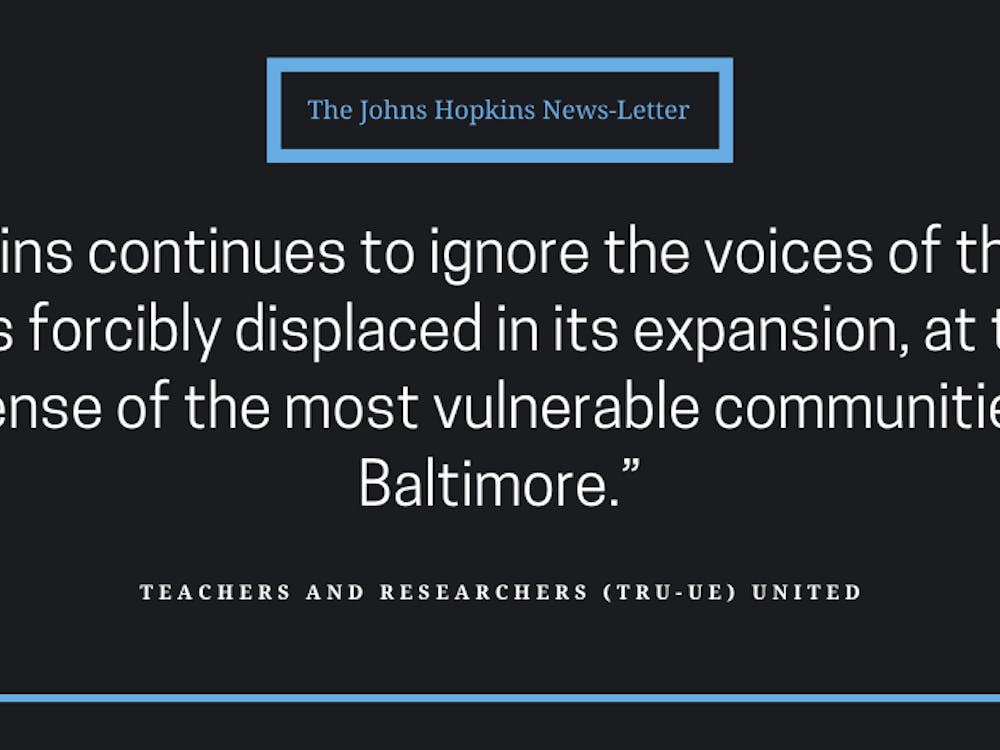For Hopkins undergraduate and graduate students, the coverage and cost of the school-sponsored health insurance program has caused confusion and dissatisfaction.
All full-time students are required to have health insurance and are automatically enrolled in the Hopkins program provided by Consolidated Health Plans (CHP) each year. However, students can waive enrollment by demonstrating that they have a comparable provider.
According to Laura J. Douglas, the University’s senior benefits analyst, approximately 44 percent of full-time undergraduate and graduate students in KSAS and WSE are enrolled in the school insurance program.
“The university requires students and employees to have health insurance to ensure they have access to health care and are protected against catastrophic events,” she wrote in an email to The News-Letter.
Details of the CHP Plan
Drew DiGiorgio, the president and CEO of CHP, explained how the University’s health insurance differs from the over 200 schools in CHP’s network.
“JHU’s plan is very comprehensive. Under [the Affordable Care Act] student health plans must meet a standard of coverage,” he wrote in an email to The News-Letter. “JHU’s plan meets those requirements and does so with very low deductibles and copays for students.”
CHP is a Preferred Provider Organization (PPO) which means that it combines in-network coverage, including physicians and hospitals that participate in the CHP’s specific health care plan, with out-of-network coverage.
CHP’s plan includes a deductible, co-insurance payment and out-of-pocket maximum. The deductible, or the amount an individual must pay before insurance begins to pay for covered services, is $250. Co-insurance payments, or the amount an individual pays for a covered service, are typically 20 percent of the billed amount. The out-of-pocket maximum, or the maximum annual sum that an individual can pay, is $5250.
The plan covers a range of health services including birth control, immunization, vaccinations, outpatient surgery, diagnostic tests, imaging tests and mental health and substance abuse care. Some services such as cosmetic surgery, dental care and routine eye care are excluded from the plan.
The University’s Student Health and Wellness Center (HelWell) offers certain services at a reduced cost. For example, a prescription for a 30-day supply of generic and preferred drugs is reduced to a flat copay fee of $8.
Worth the cost?
The school insurance plan costs $900 per semester, or $1800 annually. Although insurance plans vary in terms of covered health services and benefits, the price of health insurance at Hopkins is less than the average cost at the University’s peer institutions. The average annual cost of health insurance for undergraduates amongst the top 25 universities, as ranked by US News & World Report, is approximately $2797.73, according to The News-Letter’s calculations.*
Sophomore Osiris Mancera was unhappy with the high cost of the school’s insurance program and switched to a different health insurance provider after finishing her freshman year.
“I was here over the summer and I had gotten sick,” she said. “[I made an] appointment to go to HelWell. They had to cancel my appointment and couldn’t do certain times, and I was working full-time over the summer. So, I started thinking, what is my money really paying for if they can’t help me?”
Mancera found a plan through Maryland Health Connection, the state’s official health insurance marketplace. Although she is no longer enrolled in the school insurance plan, Mancera still goes to HelWell for vaccinations and check-ups. She pays out-of-pocket for the portion of these services that is not covered by her Maryland Health Connection plan. She acknowledged that the school’s plan can be a reliable option for many students.
“I think it’s a good plan if you can afford it and if it’s convenient for you,” she said. “But I don’t think that based on how much [it] costs it provides adequate or sufficient support and resources. It doesn’t cover certain things [like] going to the eye doctor or going to the dentist — it might give you partial [coverage] like 10 percent.”
Some students, like junior Pranshu Bhardwaj, believe that even though the school insurance program may be expensive, it is worth the cost.
“[Insurance] does cost money,” he said. “It’s a preventative measure that I feel will save you a lot of money down the line. You never know when accidents are going to happen.
He also cited the convenience of enrolling in CHP as one of its positive attributes.
“Basically, the real benefit of CHP is the ease of it,” Bhardwaj said. “I’m a college kid. I don’t really want to think about bills and insurance already. It’s just something I can tack onto my tuition.”
Sophomore Cassidy Speller also expressed approval for the health insurance program.
“I think it’s cool that the school offers a decent, if not pretty good, health insurance plan for students,” she said.
Speller noted that many people assume that all University students can afford to have their own insurance plans, yet that assumption doesn’t hold true for all.
“I don’t know how often people talk about their insurance plans, but I feel like there is a stigma [around] having a school insurance plan... if you don’t have a great insurance plan, that’s a socio-economic thing people can be judge-y about,” she said.
DiGiorgio stated that costs for student health insurance are reliant on the economy.
“Medical Trend (depending on the source) is roughly 8 percent in the student market,” he wrote in an email to The News-Letter. “That means that without altering benefits, on average, student insurance premiums would need to increase by 8 percent to keep up with medical inflation. The rate for students entirely dependent on the medical experience of the plan. Therefore that rate will vary widely from campus to campus. All schools go through a process of evaluating the cost of the plan and the benefits offered to determine the best fit for their students.”
Students who qualify for financial aid may be able to receive assistance in paying for the cost of the school insurance program.
“We automatically cover the cost of health insurance with JHU grant for students receiving Pell grants who need to sign-up for the student plan,” Douglas wrote in an email to The News-Letter. “Other students who must sign-up for the plan may request aid to help cover the expense on a case by case basis.”
Confusion over health coverage
Several student are enrolled in the school insurance program, but don’t know any details about it. Sophomore Aksel Kohen, an international student from Turkey, described his own confusion about what exactly the program covers.
“Unfortunately I don’t know so much about the insurance plan,” Kohen wrote in an email to The News-Letter. “I’ve never had to use it. All I know is that international students are obliged to enroll in the University-sponsored one, so I enrolled.”
Even students who need to use their school insurance program aren’t informed about what it covers. Speller admitted that the program is difficult to understand and that she has been confused about what is covered, and what isn’t.
“I feel like there could be some kind of clear website that is very upfront about what comes with the health insurance plan, what steps a student should take to make sure everything is in place to use it, rather than having it buried in 50 pages of some kind of insurance jargon that I don’t know and I don’t want to read,” she said.
Bhardwaj stated that his knowledge about the program is limited.
“I’m fairly certain it’s just like preventative care. I’m not really sure. It’s just the insurance that I use here in Baltimore,” he said.
Impact on graduate students
Teachers and Researchers United (TRU), a group of graduate students, is working to obtain better health insurance for graduate workers. Since graduate students are also considered full-time students, they are enrolled in the same CHP plan as undergraduate students.
In 2015, TRU released a Report on Healthcare and Call for Solidarity that cites many of the problems graduate students see with the University’s current health insurance program and compares it to the insurance programs at other schools.
Valentina Dallona, a fourth year sociology Ph.D candidate and member of TRU, explained that many graduate students are unsatisfied with the school insurance program because of its costs.
“In general, these high co-pays and high deductibles are very problematic for graduate students because we do not really have a considerable income,” she said. “We live on a stipend that is okay enough to have a modest kind of living. There’s a lot of students who just avoid seeking medical care if they have issues because they cannot afford those kinds of expenses.”
International students with F1 or J1 Visa status are required to purchase the school’s insurance program and cannot waive enrollment, according to the Office of the Registrar’s website. Dallona estimates that around two-thirds of graduate students are international students. Many international students come from countries in Europe where healthcare is provided at a national level.
“We have exactly the [same plan as undergraduates],” she said. “But in our case, because a lot of us are older or international students, we don’t have a comparable plan and we can’t rely on our parents. So a lot of us have to buy the university’s provided plan.”
Dallona recounted how she would fly back to Italy during her first year to receive health services. She also spoke about another graduate student who was unable to afford the cost of filling two cavities. Each filling would have cost her $1600, or $3200 in total. She decided to purchase a plane ticket back to France in the middle of the semester and get her cavities filled there because it was cheaper.
Dallona stated that TRU aims to be a platform for graduate workers and to improve the health insurance available for graduate students.
“It feels so ridiculous that we are [connected to] one of the most famous medical campuses and we have a very indecent healthcare plan,” she said.
The future of student health insurance
The Trump administration’s promise to repeal and replace the Affordable Care Act (ACA) has made some students worried about the effects such legislation would have on their health insurance.
Douglas stated that the University will still offer health insurance if the ACA is repealed.
“Students were provided with health insurance options before the ACA was enacted. That will not change should the ACA be repealed,” she wrote in an email to The News-Letter. “We can’t speak to what the future requirements may be but we will comply with any new regulations should the ACA be repealed and replaced.”
DiGiorgio explained what a repeal of ACA would mean for CHP.
“In general, colleges and universities determine the level of benefits offered by the CHP plan,” he wrote in an email to The News-Letter. “Schools must weigh the cost of health care, with the financial means of their student population. So technically, nothing from a benefits standpoint would need to change. However, a repeal of ACA most likely would remove the minimum requirement and allow schools to tailor benefits to meet student needs (both medical and financial).”
Bhardwaj expressed concern over how the future of health insurance may affect individuals seeking a career in medical fields.
“I think especially with the ACA going down in flames it’s going to be interesting to see how that affects how many uninsured there are, because a lot of [their] costs go to the hospitals,” he said. “As a [hopeful future doctor], I know that a lot of people are scared to see if this is going to tip the health care system one way or another. We’ll see how it goes.”
In addition to concerns about the future of the ACA, some students are worried about how immigration policies may affect health coverage. Undocumented students and individuals protected under Deferred Action for Childhood Arrivals (DACA) will still have access to health insurance so long as they maintain their status as a student, according to DiGiorgio.
“To participate in the student plan, individuals must be students (or dependents of students),” he wrote. “This is not a CHP determination.”
*The News-Letter calculated the average annual cost of health insurance for undergraduates using the top 25 schools according to U.S. News and World Report rankings. Three schools, University of Notre Dame, Massachusetts Institute of Technology and Emory University, were excluded from calculations because health insurance is either included in the cost of tuition or not mandated.























Please note All comments are eligible for publication in The News-Letter.